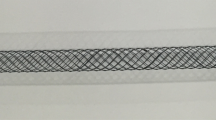Abstract
Background
Various types of self-expandable metallic stents (SEMSs) are commercially available. However, few reports have compared the performance of the various SEMSs. In addition to long-term patency, maneuverability during initial placement and feasibility of re-intervention for the stent occlusion are also very important.
Methods
In this retrospective analysis, we compared the duration of stent patency and frequency of re-interventions in 96 patients diagnosed with unresectable hilar biliary strictures in whom initial 10-mm SEMSs were inserted between June 1999 and November 2008.
Results
Based on Kaplan–Meier curves, significantly shorter patency duration was noted for SEMSs with moderate axial force (AF) than for other groups of SEMSs with low AF. Endoscopic re-interventions for SEMS occlusion were easier in a group of SEMSs with low AF and large cell width than in other groups of SEMSs.
Conclusions
With respect to patency duration and the frequency of re-intervention required, we consider that SEMSs with low AF and large cell width are favorable for hilar biliary strictures.




Similar content being viewed by others
References
Paik WH, Park YS, Hwang JH, Lee SH, Yoon CJ, Kang SG, et al. Palliative treatment with self-expandable metallic stents in patients with advanced type III or IV hilar cholangiocarcinoma: a percutaneous versus endoscopic approach. Gastrointest Endosc. 2009;69:55–62.
Ferreira LE, Baron TH. Endoscopic stenting for palliation of malignant biliary obstruction. Expert Rev Med Devices. 2010;7:681–91.
Jeong YW, Shin KD, Kim SH, Kim IH, Kim SW, Lee KA, et al. The safety assessment of percutaneous transhepatic transpapillary stent insertion in malignant obstructive jaundice: regarding the risk of pancreatitis and the effect of preliminary endoscopic sphincterotomy. Korean J Gastroenterol. 2009;54:390–4 (in Korean with English abstract).
Lee JH, Kang DH, Kim JY, Lee SM, Kim DH, Park CW, et al. Endoscopic bilateral metal stent placement for advanced hilar cholangiocarcinoma: a pilot study of a newly designed Y stent. Gastrointest Endosc. 2007;66:364–9.
Park DH, Lee SS, Moon JH, Choi HJ, Cha SW, Kim JH, et al. Newly designed stent for endoscopic bilateral stent-in-stent placement of metallic stents in patients with malignant hilar biliary strictures: multicenter prospective feasibility study (with videos). Gastrointest Endosc. 2009;69:1357–60.
Kawamoto H, Tsutsumi K, Harada R, Fujii M, Kato H, Hirao K, et al. Endoscopic deployment of multiple JOSTENT SelfX is effective and safe in treatment of malignant hilar biliary strictures. Clin Gastroenterol Hepatol. 2008;6:401–8.
Naitoh I, Ohara H, Nakazawa T, Ando T, Hayashi K, Okumura F, et al. Unilateral versus bilateral endoscopic metal stenting for malignant hilar biliary obstruction. J Gastroenterol Hepatol. 2009;24:552–7.
Silverman W, Slivka A. New technique for bilateral metal mesh stent insertion to treat hilar cholangiocarcinoma. Gastrointest Endosc. 1996;43:61–3.
Gerhardt T, Rings D, Höblinger A, Heller J, Sauerbruch T, Schepke M. Combination of bilateral metal stenting and trans-stent photodynamic therapy for palliative treatment of hilar cholangiocarcinoma. Z Gastroenterol. 2010;48:28–32.
Chahal P, Baron TH. Expandable metal stents for endoscopic bilateral stent-within-stent placement for malignant hilar biliary obstruction. Gastrointest Endosc. 2010;71:195–9.
Kim JY, Kang DH, Kim HW, Choi CW, Kim ID, Hwang JH, et al. Usefulness of slimmer and open-cell-design stents for endoscopic bilateral stenting and endoscopic revision in patients with hilar cholangiocarcinoma (with video). Gastrointest Endosc. 2009;70:1109–15.
Hwang JC, Kim JH, Lim SG, Kim SS, Yoo BM, Cho SW, et al. Y-shaped endoscopic bilateral metal stent placement for malignant hilar biliary obstruction: prospective long-term study. Scand J Gastroenterol. 2011;46:326–32.
Kogure H, Isayama H, Nakai Y, Tsujino T, Ito Y, Yamamoto K, et al. Newly designed large cell Niti-S stent for malignant hilar biliary obstruction: a pilot study. Surg Endosc. 2011;25:463–7.
Kanno Y, Ito K, Fujita N, Noda Y, Kobayashi G, Obana T, et al. Single-session endoscopic bilateral y-configured placement of metal stents for hilar malignant biliary obstruction. Dig Endosc. 2011;23:91–6.
Isayama H, Nakai Y, Toyokawa Y, Togawa O, Gon C, Ito Y, et al. Measurement of radial and axial forces of biliary self-expandable metallic stents. Gastrointest Endosc. 2009;70:37–44.
Wagner HJ, Knyrim K, Vakil N, Klose KJ. Plastic endoprosthesis versus metal stents in the palliative treatment of malignant hilar biliary obstruction. A prospective and randomized trial. Endoscopy. 1993;25:213–8.
Dumas R, Demuth N, Buckley M, Peten EP, Manos T, Demarquay JF, et al. Endoscopic bilateral metal stent placement for malignant hilar stenoses: identification of optimal technique. Gastrointest Endosc. 2000;51:334–8.
Cheng JL, Bruno MJ, Bergman JJ, Rauws EA, Tytgat GN, Huibregtse K. Endoscopic palliation of patients with biliary obstruction caused by nonresectable hilar cholangiocarcinoma: efficacy of self-expandable metallic Wallstents. Gastrointest Endosc. 2002;56:33–9.
Hookey LC, Le Moine O, Deviere J. Use of temporary plastic stent to facilitate the placement of multiple self-expanding metal stents in malignant biliary hilar strictures. Gastrointest Endosc. 2005;62:605–9.
Chen JH, Sun CK, Liao CS, Chua CS. Self-expandable metallic stents for malignant biliary obstruction: Efficacy on proximal and distal tumors. World J Gastroenterol. 2006;12:119–22.
Saleem A, Baron TH, Gostout CJ. Large-diameter therapeutic channel duodenoscope to facilitate simultaneous development of side-by-side self-expandable metal stents in hilar cholangiocarcinoma. Gastrointest Endosc. 2010;72:628–31.
Chennat J, Waxman I. Initial performance profile of a new 6F self-expanding metal stent for palliation of malignant hilar biliary obstruction. Gastrointest Endosc. 2010;72:632–6.
Author information
Authors and Affiliations
Corresponding author
About this article
Cite this article
Mukai, T., Yasuda, I., Isayama, H. et al. Comparison of axial force and cell width of self-expandable metallic stents: which type of stent is better suited for hilar biliary strictures?. J Hepatobiliary Pancreat Sci 18, 646–652 (2011). https://doi.org/10.1007/s00534-011-0406-5
Published:
Issue Date:
DOI: https://doi.org/10.1007/s00534-011-0406-5




